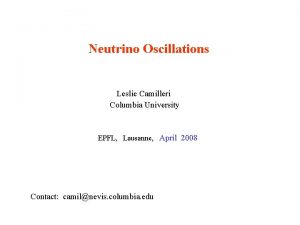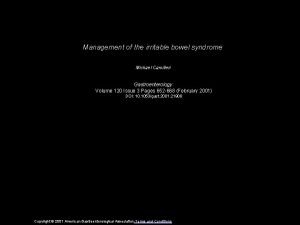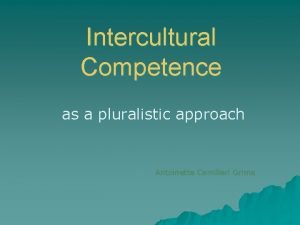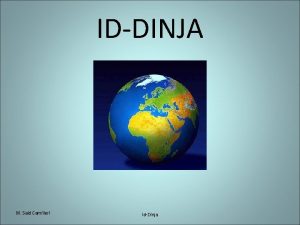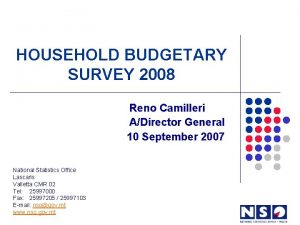The State of what Anthony F Camilleri Digital

































- Slides: 33

The State of what Anthony F. Camilleri Digital Education Report from the conference I lear ned

Openness and Equity in Digital Education

Lesson 1 open 3 access pedagogy licenses content practices

Lesson 1 open 4 education is increasingly a reality for more people

Lesson 2 digital multiplies opportunities which the well-off are best positioned to take advantage of 5

Lesson 2 In Europe access to Higher Education is inequitable gender balance A student from low socioeconomic background net entry rates entry via alternative routes - less likely to attend Higher Education participation based on occupational / - likely to choose different courses of study educational background income gap of students - more likely to work during studies ratios of foreign students - far less likely to have a mobility experience 6

Lesson 2 80 70 60 50 40 30 20 10 0 2125 Tertiary 1970 -1980 7 First stage secondary 2000 -2010 Participation in Higher Education based on parents’ income

Lesson 2 for digital to increase equity we need better ideas 8

Systems for Accreditation & Quality Assurance of Online Learning 9

Conclusion 3 Trust is about Perception 10

Conclusion 3 We need to leave our bubble to change perceptions 11

Lesson 4 We have all the technologies we need for open quality, open recognition, open accreditation 12

Lesson 4 Accreditation & QA of digital learning are a scale-up problem 13

Innovation & Digital Pedagogies

Lesson 5 European Publicly Funded HE is the real use case for (original) MOOCs 15

Lesson 6 Unbundling is unstoppable who will lead the micro-credentials revolution? 16

Lesson 7 (Digital) Pedagogies are still immature 17

Teachers, learners and digital education 18

Lesson 8 There is a massive digital divide within our institutions 19

Lesson 9 Technology has already created a global faculty and student body 20

Future trends in digital education 21

Lesson 10 Are we resisting change ourselves? 22

Lesson 10 Are we resisting change ourselves? “We share the societal aspiration that the student body entering, participating in and completing higher education at all levels should reflect the diversity of our populations” London ‘Bologna’ Communique’ 23

Lesson 11 The dominant paradigm in looking at the future is CHANGE 24

Lesson 11 The dominant paradigm in looking at the future is DISRUPTION 25

Lesson 11 The dominant paradigm in looking at the future is FEAR 26

Best Practices in Policy Design for Digital Education 27

Lesson 11 The Outlines of Immediate Policy Action are Clear • mainstreaming open access • establishing quality assurance schemes • establishing mechanisms for digital trust verification • training of teachers • supporting the development of micro-credentials • expanded use of distance and blended methodologies 28

Lesson 12 What are the desirable future scenarios for our society? What is digital education’s role in accelerating it? 29 • Learning to know • Learning to do • Learning to be • Learning to live together

Lesson 13 The State of Digital Education Today is reactive 30

Lesson 13 Stop Reacting The role of Education is to Lead 31

Lesson 13 “There has never been a time when people from across the globe have to come together to learn at this scale” Jeff Haywood 32

What did you learn today? anthony@knowledgeinnovation. eu https: //www. slideshare. net/anthonycamilleri/
 Therese camilleri
Therese camilleri Anna camilleri
Anna camilleri Maltese christmas traditions
Maltese christmas traditions Leslie camilleri
Leslie camilleri Dr michael camilleri
Dr michael camilleri Antoinette camilleri
Antoinette camilleri Hát kết hợp bộ gõ cơ thể
Hát kết hợp bộ gõ cơ thể Lp html
Lp html Bổ thể
Bổ thể Tỉ lệ cơ thể trẻ em
Tỉ lệ cơ thể trẻ em Chó sói
Chó sói Thang điểm glasgow
Thang điểm glasgow Chúa sống lại
Chúa sống lại Môn thể thao bắt đầu bằng từ chạy
Môn thể thao bắt đầu bằng từ chạy Thế nào là hệ số cao nhất
Thế nào là hệ số cao nhất Các châu lục và đại dương trên thế giới
Các châu lục và đại dương trên thế giới Công của trọng lực
Công của trọng lực Trời xanh đây là của chúng ta thể thơ
Trời xanh đây là của chúng ta thể thơ Mật thư tọa độ 5x5
Mật thư tọa độ 5x5 Làm thế nào để 102-1=99
Làm thế nào để 102-1=99 độ dài liên kết
độ dài liên kết Các châu lục và đại dương trên thế giới
Các châu lục và đại dương trên thế giới Thể thơ truyền thống
Thể thơ truyền thống Quá trình desamine hóa có thể tạo ra
Quá trình desamine hóa có thể tạo ra Một số thể thơ truyền thống
Một số thể thơ truyền thống Cái miệng bé xinh thế chỉ nói điều hay thôi
Cái miệng bé xinh thế chỉ nói điều hay thôi Vẽ hình chiếu vuông góc của vật thể sau
Vẽ hình chiếu vuông góc của vật thể sau Biện pháp chống mỏi cơ
Biện pháp chống mỏi cơ đặc điểm cơ thể của người tối cổ
đặc điểm cơ thể của người tối cổ Thế nào là giọng cùng tên?
Thế nào là giọng cùng tên? Vẽ hình chiếu đứng bằng cạnh của vật thể
Vẽ hình chiếu đứng bằng cạnh của vật thể Tia chieu sa te
Tia chieu sa te Thẻ vin
Thẻ vin đại từ thay thế
đại từ thay thế



